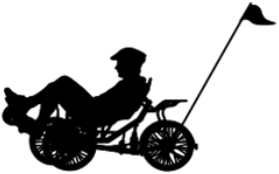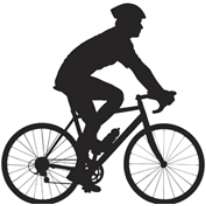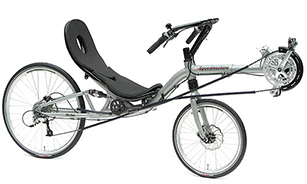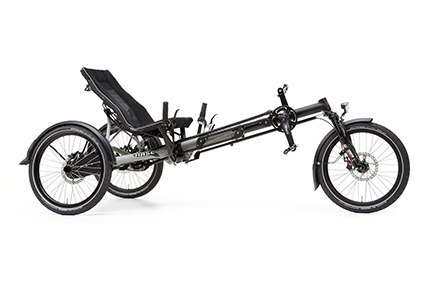There’s a Bike for Everyone
We’re converting both avid cyclists and beginners with the laid-back design of our recumbent bicycles. Bent bikes range in style and function – but all provide a stable and supportive ride. Discover the benefits of different configurations and decide which style will work best for your situation. From foot-powered to hand-powered, find your perfect fit!
Cycling is a great option for low-impact cardiovascular activity. But sometimes biking with a traditional upright cycle can be uncomfortable, especially for those with low back pain. And let’s be honest, a traditional bike saddle isn’t exactly the most comfortable seat around. Upright cycles can also be difficult to handle and unstable for those with balance concerns.
With traditional cycles, the pedals are positioned under the body where the body is in an upright body position. With a recumbent cycle, the pedals are positioned in front of the body and the body is in a reclined position. Your body weight is more evenly distributed across a larger surface area and seats tend to be larger with back support. All of this makes for a much more comfortable, and stable, ride.



Recumbent Cycle
Reclined body position
More comfortable, natural, reclined position helps reduce body fatigue and muscle soreness in wrists, shoulders, and back
Leverage back of seat and engage back, core, and leg muscles to pedal

Traditional Cycle
Upright body position
Slightly hunched over with slight bend in neck and back; smaller seat creates what’s known as “saddle soreness”.
Leverage body weight and engage leg and core muscles to pedal
Beyond comfort and stability, there’s other benefits to riding ‘bent’:
- You’ll maximize your pedal power by being able to push against the back seat, leveraging your muscles rather than your weight
- You’ll experience better aerodynamics (did you know the human powered speed record was achieved on a recumbent?).
- Your legs are elevated for more efficient blood flow to more easily get oxygen to your muscles
- Your field of view is different on a recumbent – you’ll be able to see and enjoy more of your ride as your head will be looking out opposed to down.
A recumbent cycle might be right for you if…
- You find it uncomfortable to ride a traditional upright bike as you experience wrist, back, shoulder, and/or knee pain or experience prostate pain
- You are concerned about balance or stability
- You can’t ride a traditional cycle and need something built for your adaptive needs
- You prefer to ride a bike without the constant feeling of a wedgie 😉
You’ve decided you want a recumbent cycle – but what kind? Recumbent cycles come in many forms and configurations. While two wheel recumbents generally offer speed and agility, three wheel recumbents offer stability, greater comfort, and a more relaxed ride. What’s best for you is based on your needs and how and where you will ride. Read on to learn more about the types of recumbent cycles:



Two Wheeled Recumbent Cycles
- Semi-Recumbent or Crank Forward Bikes
- Looks most similar to traditional upright bike but crank is located forward, or in front, of the body; seat may or may not have back support
- Example: Day 6 Dream, Rans Fusion
- Recumbent Short Wheelbase Bikes
- Recumbent cycle with the crank located in-front of the the front wheel
- Example: Rans Rocket, Rans Rifle, HP Velotechnik Streetmachine GTE
- Recumbent Long Wheelbase Bikes
- Recumbent cycle with crank located between the front and back wheel
- Example: Rans Stratus, Ryan Vanguard

Three Wheeled Recumbent Cycles
- Tadpole Bikes
- Two wheels in the front, one wheel in the back
- Example: All Terra Trikes and Catrike models, Greenspeed, HP Velotechnik Gekko or Scorpion
- Delta Bikes
- One wheel in the front, two wheels in the back
- Example: Hase Kettwiesel or Trigo, Van Raam Easy Rider
When it comes to recumbent trikes, there are two configurations: Tadpoles (two wheels in the front, one wheel in the back) and Deltas (one wheel in the front, two wheels in the back). Generally speaking, tadpoles are may be the best choice for riders prioritizing speed and stability over maneuverability and on/ off access. Deltas, on the other hand, may be the best choice for riders who prioritize maneuverability and versatility over speed.



Tadpole
- Better handline at top speeds
- More stability
- Typically lower ot the ground
- Depending on person, may be more difficult to get on and off
Best choice when speed and stability is prioritized over maneuverability.

Delta
- Tighter turning radius and better maneuverability
- Easy to get on and off, especially for those with mobility concerns
- Requires more steering control; difficult to see rear wheels
- Typically higher center of gravity
Best choice when maneuverability and versatility are a prioritized over speed.
Ultimately, it comes down to what you, the rider, finds most comfortable. That’s why we recommend you schedule time to come to our shop and test ride different configurations and models. This allows for you to experience the ride of each cycle with support from us in customizing the cycle to your needs and answering any questions.
Cycling is a great option for low-impact cardiovascular activity and most people feel that using power assist takes away from the benefit of riding in the first place. The truth of the matter is that power assisted cycles help supplement the rider’s efforts, not replace them.
Power assist cycles are different from what most people think of as electric bikes. Electric bikes are driven by throttle giving power to a motor that pulls, and in some cases pushes, the bike in the direction you want to go. Power on electric bikes is either on or off and doesn’t require you to pedal.
In contrast, power assisted cycles use torque sensors to measure the amount of torque (forward motion pedal power) you place on the pedals and match it to some degree. Motors on powered assisted cycles won’t engage unless you are pedaling and you can control the amount of power assist you receive from the motor. For example, a power assist cycle on an ‘eco’ level may supplement your pedaling with torque equivalent to 25% of what you are putting in pedaling. Upon switching to ‘max’ power on a hill for instance, your power assist motor would supplement your pedaling with torque equivalent to 100% of what you are putting in pedaling. In this case, the pedaling energy you put in is being matched by the motor.
Power assist cycles can be great options for commuters or those who lack confidence in their ability to go long distances. Most of our customers who purchase cycles with power assist see it as an ‘insurance plan’. They love riding so much and are so comfortable that they lose track of how far they rode – having power assist gives them assurance they can make it back home and not be completely spent.
We offer several types of power assist cycles in our shop and can install aftermarket kits should you decide you’d like to add a power assist motor down the road. Here’s a quick review of some of the power assist cycles we offer:
- Day 6 Patriot (Falco e-motor)
- Terra Trike Evo (Falco e-motor) or external gear hub models with Copenhagen Wheel Kit (26” wheels only)
- Catrike models with Bionix Motor Kit or Copenhagen Wheel Kit (26” wheels only)
- Hase models with Shimano Steps
- HP Velotechnik models with Shimano Steps or GO SWISS
Helping you find the right cycle is only the first part of our job. Once you select your cycle, we’ll fit and customize your cycle to you and your needs.
We’ll start with sizing your trike and adjust the boom to your length (or x-seam) so you have a slight 10-15 degree bend in your knee when fully extended. We’ll find the optimal seat recline for performance and comfort and see if further neck or hand support are needed. We’ll also check should contact, ensuring you have a gentle, comfortable bend at the elbow.
Once your trike is appropriately sized, we’ll have you do a little pedaling and turning to see how the cycle responds to you and how you feel. We can fine-tune adjustments and even add accessories to further adapt the cycle to your needs. Some examples of this include:
- Adding assist bars, or standing aids, to help you get on and off your cycle
- Changing out pedals to create better contact between foot and pedal
- Mounting mirrors and lights for safety, water bottle holders for hydration, or racks and bags for storage
- Adding crank shorteners to adjust for individual leg length and knee mobility
- Replacing traditional thumb shifters with twist shifters to accommodate hand strength and dexterity concerns
At the end of your visit, you’ll have a cycle fully customized to you and your needs with ample opportunity to ride to ensure maximum comfort and performance.
We believe everyone should be able enjoy the freedom, fun, and fitness that comes from riding a bike. For us it’s not a question of if someone with adaptive needs can ride a bike – only a question of which combination of cycles and tools we need to make it happen.
We carry several styles of cycles to build on your abilities and get you out riding. Unable to pedal with your legs? No problem – let’s try a hand cycle. Looking to build upper and lower muscle in recovery from a stroke? We’ve got a Berkel bike for you to try. Unable to steer with your hands? Let’s try shoulder steering. As long as you have the will and desire to bike – we’ll have the drive and knowledge to build a cycle that helps you ride.
We carry:
- Hand cycles from Top End/ Invacare and Hase
- Highly adaptable cycles from Hase and HP Velotechnik
- Berkel Bike and special needs cycles from RAD Innovations
- Wheel chair and adaptive tandem cycles from Van Raam
Contact us to to schedule a one on one appointment so we can discuss your abilities and needs and work together to discover a cycling solution.
